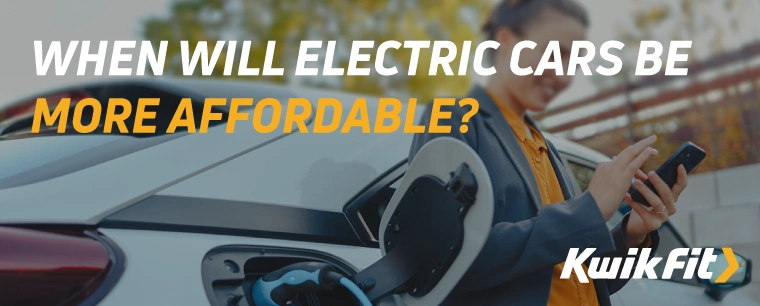When Will Electric Cars Be More Affordable
Jack Dreyer | Wednesday 31st July 2024 12:00pm

Over the past five years, electric vehicles (or EVs, as they are commonly called) have been steadily gaining popularity in the automotive industry — and for good reason too.
Owing to their significant environmental benefits and exemptions from certain taxes, each year, more and more drivers make the switch to electric and hybrid from petrol and diesel.
However, despite the tax and emissions cost exemptions, electric cars are still thought of as being more expensive than their combustion engine counterparts. In this blog, we take a look at the future of EVs and speculate whether they will grow to be more affordable in years to come.
Read on for more.
Electric vehicles on the rise
In January 2024, the UK’s millionth battery electric vehicle (BEV) hit the roads. This milestone signals a major change in the position of electric vehicles from experimental to well and truly integrated into the changing face of Britain's roads.
At the end of June 2024, there were over 1,140,000 fully electric cars on the UK’s roads, demonstrating a staggering growth from under 250,000 at the end of 2020.
And the EV industry is set to continue growing - but will this bring costs down? Up until now, electric vehicles have not been widely accessible to the regular driver due to their considerably higher upfront costs. Let’s take a look at some of these costs below.
The costs of owning an electric vehicle
Up-front costs
Due to their relative novelty — in the grand scheme of things, EVs haven't been around that long at all — there is still a relatively high price tag when it comes to owning an electric car.
As of June 2024, the average price of a brand-new electric car in the UK was £54,324.61. In comparison, the cost of buying a medium-sized regular car was just £27,228 — a difference of almost half. But, when it comes to maintenance costs, EVs are, admittedly, much cheaper.
Electric vehicle running costs
The day-to-day costs associated with EVs are significantly lower than combustion engine vehicles.
‘Fuel’
Firstly, the ‘fuel’. According to recent research from Pod Point, it costs about £13 for a full charge at home. (Note: the cost of charging in a public location differs). To fill up a tank of petrol, on the other hand, you’re looking at £51.24.*
*This was calculated for a Ford Fiesta, the UK’s most common car.
Maintenance & repairs
Next, the actual maintenance costs. Many drivers are misinformed when it comes to EV maintenance thinking that, because they’re plug-ins, electric vehicles are likely to have more moving parts, more complex repairs, and higher maintenance chargers. However, we know the opposite to be true.
We have an entire blog dedicated to the running costs of regular versus electric vehicles here to carry on the comparison if you're interested.
Exemptions
One last point worth mentioning, however, is exemptions. EV owners benefit from multiple government incentives, including:
- Electric vehicle drivers do not have to pay road tax
- Congestion charges — like the ULEZ and other inner-city emissions taxes — do not apply to EV drivers
- Government grants are available for installing home charging points
- Clean air financial support scheme
But, even with all those advantages, for many potential buyers, that high up-front figure remains an off-putting concern. So, when (and will) electric cars become more affordable for the average consumer?

Will electric vehicle costs come down?
As is the case with many ‘green’ products before they become popular and more widely available, the costs make them inaccessible to many. Is there scope for cheaper EVs on the green horizon?
Technological advancements
One of the core factors keeping electric vehicle costs so high is the technology behind them.
Battery technology is a relatively new emergent field, especially in terms of its integration into automotive engineering. But, this technology, its functionality, and its capabilities are ever-advancing, meaning that costs are likely to reduce with time.
The recent developments of solid-state batteries mark a defiant stride towards greater energy density and longer battery life spans at a lower cost. Meanwhile, production techniques for EV electrical parts are improving to reduce overhead expenses. As an example, assembly lines are now automated and the recycling process is increasingly streamlined. Thanks to these gains, the bottom line cost of an EV (and the largest reason for their high sale prices) is gradually declining.
We can expect this to continue, eventually evolving into a much more economically viable and sustainable future when it comes to combustion engine alternatives. When this evolution will happen is a different question entirely — and one not yet answerable fully.
Government policies and incentives
As we spoke about above, there are a number of government incentives already in place that aim to bring down the running costs of electric vehicles. But what about that high sale cost? Well, they’re trying to tackle how daunting that is too.
Looking ahead, there are ongoing discussions about future policies that aim to make EVs less costly. One idea is to temporarily reduce the VAT on new EV purchases by up to half. If this idea makes it to policy, it could potentially save buyers hundreds of pounds when buying an electric vehicle.
As we get ever closer to 2035 (when the sale of new petrol and diesel cars will be banned), we can expect the UK to ramp up its promotion of EVs which may manifest in more robust incentives, increased grants, and subsidies. As well as this, it wouldn’t be out of the question to expect greater attention to charging infrastructure on the horizon too.
Economies of scale
Another factor that comes into play when considering the future costs of EV is the economy of scale. To risk stating the obvious: as electric vehicle production volumes increase, the cost per unit proportionately decreases — it’s cheaper to make in bulk.
As EVs become more and more popular, more units can be produced to meet this demand, seeing manufacturers increasingly able to spread fixed costs over a greater number of vehicles.
Second-hand EV market growth
Lastly, we have to mention the rapid growth of the second-hand market for electric vehicles and its role in making this type of vehicle more accessible for consumers.
As more new EVs are sold, the supply of used models increases. The outcome? A much broader range of options is available at a lower price. As businesses and fleets (who currently drive much of the new EV market) begin to replace their older models, we can expect this trend to start to increase more too.
A greener, cheaper future for cars?
Bearing all that in mind, then, it’s safe to say that we can expect EV sale prices to fall in the future, but it’s difficult to determine when. As more cars are made, second-hand models get more common, and EV technology gets cheaper, prices will drop.
As well as it being hard to predict the path prices will take, it’s also important to recognise that everyone’s circumstances are specific to them. Roger Griggs, Kwik Fit’s communications director says: “Like beauty, affordability is often in the eye of the beholder. We all have our own personal relationship with our cars – some people want to buy the best car they can possibly afford and will sacrifice spending in other areas to get it. Others are happy to go for a much more basic model as long as it gets them from A to B. Fortunately, the ever increasing range of EVs on the market, both new and used, will mean that there is widening choice for drivers, whatever their own criteria.”
Keep your car roadworthy in the meantime
If you’re planning to purchase an electric vehicle, but you want your combustion engine to last you in the meantime, keep it in good condition with Kwik Fit. With Free Battery Health Checks, Free Vehicle Safety Checks, and an impressive array of servicing options, we’re here to keep your wheels turning for as long as possible.
Or, if you already own an electric vehicle, keep running costs down with Kwik Fit. Getting your EV serviced regularly is a form of preventative maintenance and will reduce the likelihood of costly repairs as a result of unexpected issues going undetected.
For the latest electric vehicle and regular motoring updates, keep up to date with the Kwik Fit blog. Or, if you have any questions, get in touch with our friendly team of experts.
Any facts, figures and prices shown in our blog articles are correct at time of publication.
Featured Articles
Is it Illegal to Drive With One Headlight?
Saturday 19th July 2025
Wondering if it’s illegal to drive with one headlight? Learn about the safety risks and penalties of illegal blown bulbs and why you should fix them promptly.
Air Con in EVs & Hybrids: Experts Answer Your Questions
Monday 30th June 2025
Does air con drain EV batteries? Can you use the air con while charging an electric car? Find out the answers to these questions & more from Kwik Fit’s experts.
Why Is Your Car Making a Noise? Fixes & Tips
Friday 13th June 2025
When your car starts making unexpected noises, it can certainly be quite disconcerting; it may be nothing to worry about, but here’s what you need to know.









